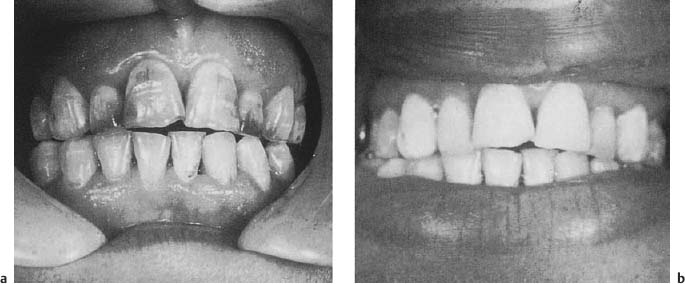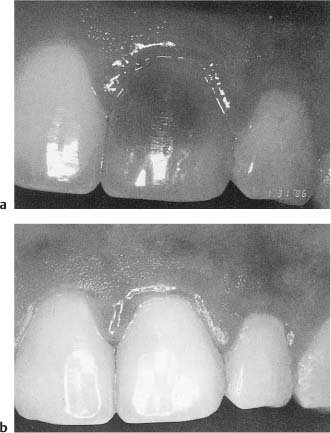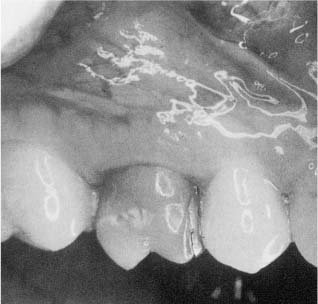15
Bleaching of Discolored Teeth
Discoloration of the teeth, especially the anterior teeth, may become a serious aesthetic problem. The problem may be corrected by bleaching the teeth, although the success of bleaching therapy is strongly dependent on the nature of the discoloration.
Discoloration of Teeth
Vital Teeth
Secondary mineralization. Obliteration of the pulp chamber and the tubules of the coronal dentin may occur especially after concussion and subluxation injuries of the teeth. The increased mineralization leads to a loss of translucency of the crown with a yellowish-brownish discoloration. Most often, this type of discoloration is mild and aesthetically not very disturbing. In photographs, however, these teeth may appear dark and it is often because of this that a patient seeks treatment.
Enamel defects. In teeth with enamel hypo-calcifications and hypoplasia, the enamel has defects and may be porous. Stains are readily taken up from the oral cavity in the defective areas, and in teeth with severe anomalies (amelogenesis imperfecta) the results may be aesthetically very disturbing. Severe discolorations are also seen in patients who have been exposed to excessive amounts of fluoride during tooth formation (Fig. 15.1). Excessive fluoride intake causes disturbances in the mineralization of the dental tissues, resulting in localized, or in severe cases, generalized porosities and defects in the enamel.
Systemic drugs. The administration of systemic drugs during tooth formation may cause tooth discoloration and severe aesthetic problems. The most dramatic example of this is tetracycline staining of teeth. The teeth may be yellow to yellowish-brown or light to very dark gray, depending on the type of tetracycline used. The discoloration is due to the drug binding to the hydroxyapatite crystals of the area of the tooth which is being formed during the time of the administration of the drug. Because of the age of a child when the incisors are formed, tetracycline discoloration affects the dentin more than the enamel. Tetracycline discoloration of teeth is a phenomenon well known to physicians today and the use of this drug in pregnant women and children under 8–9years of age has virtually stopped.
Fig. 15.1
a Patient with brown discoloration of the teeth due to generalized fluorosis.
b Removal of discolorations is observed following vital bleaching therapy.
Fig. 15.2
a Severe bluish-black discoloration of a maxillary left central incisor with necrotic pulp. The discoloration is caused by breakdown products from tissue and blood penetrating into the dentinal tubules.
b Excellent aesthetic results following endodontic treatment, bleaching, and restoration of the access cavity with the acid-etch resin technique.
Fig. 15.3 Maxillary molar with a large MOD amalgam restoration. A grayish-bluish discoloration of the entire tooth can be seen.
Other substances, for example, iron, are known to cause a certain discoloration of teeth. However, today this is seen extremely rarely and is not a clinical problem.
Nonvital Teeth
Pulp necrosis. Necrotic tissue is a major cause of tooth discoloration (Fig. 15.2). Breakdown products from tissue and especially from blood infiltrate the dentinal tubules and give the tooth a brownish-gray discoloration. Sometimes the discoloration may be very dark, almost bluish-black. Apparently this is due to the formation of an iron sulfide compound in the tubules with iron deriving from the hemoglobin of the blood and the sulfur from bacterial products. It is important to meticulously remove all necrotic pulp tissue during endodontic treatment. For instance, the pulp horns are easily overlooked and necrotic tissue left behind in these areas where the tooth is especially thin will inevitably lead to discoloration.
Endodontic medicaments and materials. Certain medicaments and materials used in endodontic treatment may lead to tooth discoloration. The worst offenders like silver nitrate and silver-containing root canal sealers should be only of historical interest. However, all endodontic materials have to be meticulously removed from the pulp chamber when the root canal has been filled, as they will at least decrease the translucency of the tooth. Also, many materials, like zinc oxide–eugenol cements, have a tendency to darken over time when influenced by light through the enamel and dentin of the tooth.
Restorative materials. Of the restorative materials, the different amalgams may cause tooth discoloration (Fig. 15.3). The dentin in contact with the restoration and sometimes the entire crown of the tooth may turn bluish-gray. From an aesthetic point of view, this is an especially displeasing color, and amalgam restorations should never be used in anterior teeth. Thus, it follows that lingual access cavities for root canal treatment should not be obturated with amalgam fillings. This will inevitably lead to discoloration of the tooth and logically, but mistakenly, the patient will relate the discoloration to the endodontic treatment. Amalgam discolorations are difficult to correct with bleaching procedures.
Discoloration of teeth in conjunction with filling materials are otherwise seen with marginal leakage and the penetration of staining substances from tobacco, coffee, tea, red wine, etc. into the dental tissue. The use of the acid-etch technique with resin-type restorations has greatly reduced this type of discoloration.
Bleaching of Endodontically Treated Teeth
Preparation for Bleaching
If at all possible, a photograph of the patient’s teeth should be taken prior to the bleaching procedures (






